Abstract
We prove the hydrodynamic limit for the symmetric exclusion process with long jumps given by a mean zero probability transition rate with infinite variance and in contact with infinitely many reservoirs with density \(\alpha \) at the left of the system and \(\beta \) at the right of the system. The strength of the reservoirs is ruled by \(\kappa N^{-\theta }>0\). Here N is the size of the system, \(\kappa >0\) and \(\theta \in {{\mathbb {R}}}\). Our results are valid for \(\theta \le 0\). For \(\theta =0\), we obtain a collection of fractional reaction–diffusion equations indexed by the parameter \(\kappa \) and with Dirichlet boundary conditions. Their solutions also depend on \(\kappa \). For \(\theta <0\), the hydrodynamic equation corresponds to a reaction equation with Dirichlet boundary conditions. The case \(\theta > 0\) is still open. For that reason we also analyze the convergence of the unique weak solution of the equation in the case \(\theta =0\) when we send the parameter \(\kappa \) to zero. Indeed, we conjecture that the limiting profile when \(\kappa \rightarrow 0\) is the one that we should obtain when taking small values of \(\theta >0\).

Similar content being viewed by others
Change history
08 October 2020
The second equation of Theorem 3.2
Notes
In the diffusive case \(\gamma >2\) the limiting PDE is given by the heat equation with Dirichlet boundary conditions [4]. It does not depend on \(\kappa \).
References
Baldasso , R., Menezes , O., Neumann , A., Souza , R.: Exclusion process with slow boundary. J. Stat. Phys. 167, 1112–1142, 2017
Basile, G., Komorowski, T., Olla, S.: Private communication, 2015
Bernardin , C., Jiménez-Oviedo , B.: Fractional Fick’s law for the boundary driven exclusion process with long jumps. ALEA Lat. Am. J. Probab. Math. Stat. 14, 473–501, 2017
Bernardin , C., Gonçalves , P., Jiménez-Oviedo , B.: Slow to Fast infinitely extended reservoirs for the symmetric exclusion process with long jumps. Markov Process. Relat. Fields 25, 217–274, 2019
Bogdan , K., Burdzy , K., Chen , Z.-Q.: Censored stable processes. Prob. Theory Relat. fields 127, 89–152, 2003
Brezis , H.: Functional Analysis, Sobolev Spaces and Partial Differential Equations. Springer, Berlin 2010
Denisov , S., Klafter , J., Zaburdaev , V.: Levy walks. Rev. Mod. Phys. 87, 483, 2015
Dubkov , A.A., Spagnolo , B., Uchaikin , V.V.: Lévy flight superdiffusion: an introduction. Int. J. Bifurc. Chaos 18, 2649, 2008
Dhar , A.: Heat transport in low-dimensional systems. Adv. Phys. 57, 457, 2008
Dhar, A., Saito, K.: Anomalous transport and current fluctuations in a model of diffusing Levy walkers. eprint arXiv:1308.5476
Dhar , A., Saito , K., Derrida , B.: Exact solution of a Levy walk model for anomalous heat transport. Phys. Rev. E 87, 010103(R), 2013
Dyda , B.: A fractional order Hardy inequality. Illinois J. Math. 48(2), 575–588, 2004
Di Nezza , E., Palatucci , G., Valdinoci , E.: Hitchhiker’s guide to the fractional Sobolev spaces. Bull. Sci. Math. 136, 521–573, 2012
Franco , T., Gonçalves , P., Neumann , A.: Hydrodynamical behavior of symmetric exclusion with slow bonds. Ann. l’Inst. Henri Poincaré Prob. Stat. 49(2), 402–427, 2013
Guan , Q.-Y., Ma , Z.-M.: The reflected \(\alpha \)-symmetric stable processes and regional fractional Laplacian. Probab. Theory Relat. Fields 134(4), 649–694, 2006
Kipnis , C., Landim , C.: Scaling Limits of Interacting Particle Systems. Springer, New York 1999
Kipnis , C., Landim , C., Olla , S.: Hydrodynamic limit for a non-gradient system: the generalized symmetric exclusion process. Comm. Pure Appl. Math. 47(11), 1475–1545, 1994
Kundu , A., Bernardin , C., Saito , K., Kundu , A., Dhar , A.: Fractional equation description of an open anomalous heat conduction set-up. J. Stat. Mech. Theory Exp. 1, 013205, 2019
Lepri , S., Livi , R., Politi , A.: Thermal conduction in classical low-dimensional lattices. Phys. Rep. 377, 1–80, 2003
Lepri , S., Politi , A.: Density profiles in open superdiffusive systems. Phys. Rev. E 83, 030107(R), 2011
Mou , C., Yi , Y.: Interior regularity for regional fractional Laplacian. Commun. Math. Phys 340, 233–251, 2015
Roubíček , T.: Nonlinear Partial Differential Equations with Applications, vol. 153. Springer, Berlin 2013
Vázquez , J.L.: Recent progress in the theory of nonlinear diffusion with fractional Laplacian operators. Discrete Contin. Dyn. Syst. Ser. S 7(4), 857–885, 2014
Acknowledgements
This work has been supported by the Projects EDNHS ANR-14-CE25-0011, LSD ANR-15-CE40-0020-01 of the French National Research Agency (ANR) and of the PHC Pessoa Project 37854WM. B.J.O. thanks Universidad Nacional de Costa Rica and L’institut Français d’Amérique centrale-IFAC for financial support through his Ph.D grant. P.G. thanks FCT/Portugal for support through the Project UID/MAT/04459/2013. This project has received funding from the European Research Council (ERC) under the European Union’s Horizon 2020 research and innovative programme (Grant Agreement No 715734). This work was finished during the stay of P.G. at Institut Henri Poincaré - Centre Emile Borel during the trimester “Stochastic Dynamics Out of Equilibrium”. P.G. thanks this institution for hospitality and support. The authors thank the Program Pessoa of Cooperation between Portugal and France with reference 406/4/4/2017/S.
Author information
Authors and Affiliations
Corresponding author
Additional information
Communicated by A. Garroni
Publisher's Note
Springer Nature remains neutral with regard to jurisdictional claims in published maps and institutional affiliations.
The original version of this article was revised: Due to typesetting mistakes, in equations 2.1 and 2.6 the 1 was incorrect.
Appendix A: Computations Involving the Generator
Appendix A: Computations Involving the Generator
Lemma A.1
For any \(x \ne y \in \Lambda _N\), we have
-
(i)
\(L_N^0 (\eta _x \eta _y) = \eta _x L_N^0 \eta _y + \eta _y L_N^0 \eta _x - p(y-x) (\eta _y -\eta _x)^2,\)
-
(ii)
\(L_N^r (\eta _x \eta _y) = \eta _x L_N^r \eta _y + \eta _y L_N^r \eta _x,\)
-
(iii)
\(L_N^\ell (\eta _x \eta _y) = \eta _x L_N^\ell \eta _y + \eta _y L_N^\ell \eta _x.\)
Proof
For (i) we have, by definition of \(L_N^0\), that
In order to prove (ii), note that \(\left[ (\sigma ^{\bar{x}}\eta )_{x}-\eta _{x}\right] \left[ (\sigma ^{\bar{x}}\eta )_{y}-\eta _{y}\right] \) is equal to zero, for all \({\bar{x}} \in {{\mathbb {Z}}}\). Thus, by definition of \(L_N^r\), we have that
The proof of the third expression is analogous. \(\quad \square \)
Rights and permissions
About this article
Cite this article
Bernardin, C., Gonçalves, P. & Jiménez-Oviedo, B. A Microscopic Model for a One Parameter Class of Fractional Laplacians with Dirichlet Boundary Conditions. Arch Rational Mech Anal 239, 1–48 (2021). https://doi.org/10.1007/s00205-020-01549-9
Received:
Accepted:
Published:
Issue Date:
DOI: https://doi.org/10.1007/s00205-020-01549-9




